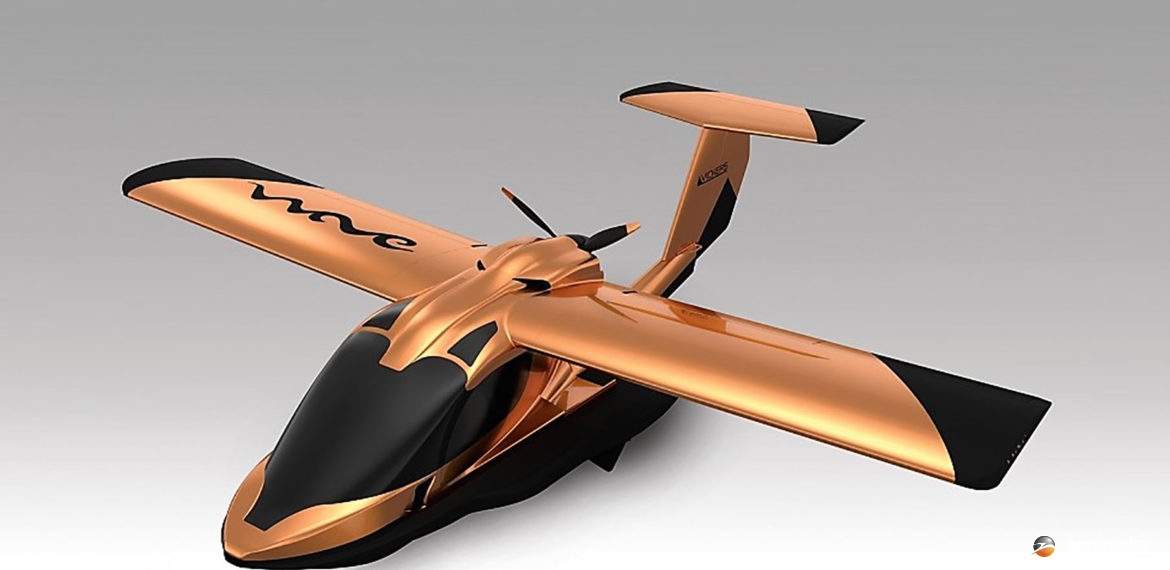Photograph:
Company drawing of the Wave amphibian (Vickers Aircraft)
Country of origin:
New Zealand
Description:
Two-seat light sport amphibian
Power Plant:
One 134 kw (180 hp) Lycoming IO-360 four-cylinder horizontally-opposed air-cooled engine
Specifications:
- Wingspan: 9.4 m (30 ft 10 in)
- Length: 7.5 m (24 ft 8 in)
- Height: 2.29 m (7 ft 6 in)
- Wing area: 13.87 m² (150 sq ft)
- Max cruising speed: 222 km/h (138 mph)
- Max range with standard tanks, no reserves: 1,333 km (828 miles)
- Take-off distance: 182 m (600 ft)
- Landing distance: 182 m (600 ft)
- Fuel capacity: 190 litres (41.8 Imp gals)
- Useful load: 227 kg (500 lb)
- Loaded weight: 648 kg (1,430 lb)
History:
The Wave amphibious light two-seat monoplane was introduced to the light aircraft market in June 2014 when the manufacturer, Vickers Aircraft Ltd of Te Rapa, near Hamilton, NZ announced the prototype of its aircraft was nearing completion and testing from an airfield near Hamilton would soon be taking place. It was the brainchild of Hamilton businessman, Paul Vickers, who stated he had spent seven years developing the project and the development had been funded from the sale of former businesses. The aircraft is aimed at the recreation market in the United States where it would be certified under US Light Sport Aircraft (LSA) Specifications.
One of the challenges with the design was to meet the FAA stipulated max take-off weight of 650 kg (1,433 lb) and in order to allow for the weight of the pilot, passenger and fuel, the airframe could not weigh more than 400 kg (882 lb). Part of the design parameter was to allow a long range, ie enough fuel to fly from Auckland to Dunedin, a distance of 1,300 km (808 miles), and still have a reserve.
Mr Vickers was formerly a boatbuilder who believed he had solved the problem with a hull design that encouraged air to flow underneath the aircraft during the take-off run. When completed the prototype would undergo a 180 hour test flying program before certification by the Civil Aviation Authority of New Zealand and reciprocal arrangements would allow the aircraft to be certified in Australia and the United States.
The Company met weight limits by using tried and trusted materials, and using recently developed technology. Machined aluminium has been used for structural parts but the hull and wing skins are constructed from light-weight carbon fibre. By October 2014 production moulds and jigs had been completed and major carbon fibre moulds had been built. A BRS Ballistic Parachute is fitted, as are powered folding wings for storage or towing, sliding doors, and enough space in the cabin to eventually allow for a four-seat variant to be built. The aircraft has an electric retractable water thruster for engine-off on-water manoeuvring, and a Vertical Power digital electric management system.
The aircraft is fitted with a Dynon Sky View SV-D 1000 avionics suite integrating a 25.4 cm (10 in) single, tough, high-resolution screen, a Sky View suite which included a COM-C25 CON radio, Sky View 2S stereo intercom, SV.XPNDR-261 transponder and a Mode S transponder. It also has a facility for an I-Pad mini EFB, an autopilot, and a centre console joystick.
A special type of tricycle undercarriage has been designed for the aircraft featuring as many as seven wheels and, because of the design, does not need to be retracted. The undercarriage pivots enough to aid crosswind landings on hard surfaces.
One of the major contributors to the program is Core Builder Composites, a New Zealand company involved with sailing, developing and building the 21.94 m (72 ft) catamaran Oracle which won the America’s Cup, being one of the fastest yachts in the world using a sail that presented as a half aircraft wing rather than a fabric sail.
Power was initially to be supplied by a fuel-injected Lycoming IO-360 four-cylinder engine driving a 1.83 m (72 inch) Catto three-blade propeller in the pusher configuration. However, in June 2015 it was announced a new strategic partnership had been formed with Continental Motors and it was stated that the Titan IO-340CC four-cylinder horizontally-opposed air-cooled engine would be installed in production aircraft. This new engine has weight savings to allow the aircraft to comply with the LSA ASTM standards without comprising reliability or safety. It uses magnesium alloys in certain parts to assist in the reduction of weight.
The Company has received investment from American operators and by early 2016 the prototype was close to flying. Components were in production for customer aircraft. The Company was also looking for a facility in the United States to base Vickers Aircraft USA for sales, training and delivery facilities. Deliveries of production aircraft were expected to commence in mid-2016. However, by late 2019 no aircraft was known to have been completed and registered.
In early 2021 the first aircraft was nearing completion and became ZK-VIC (c/n POC01) registered to Vickers Aircraft Company Ltd at Hamilton, the Company at the time announcing it was not proceeding by way of a prototype and had commenced production.

